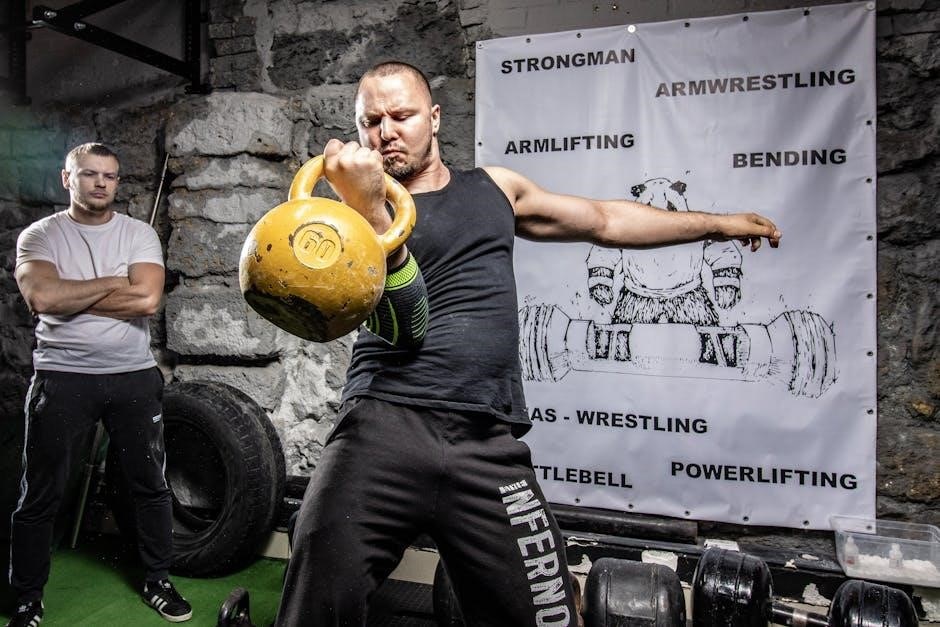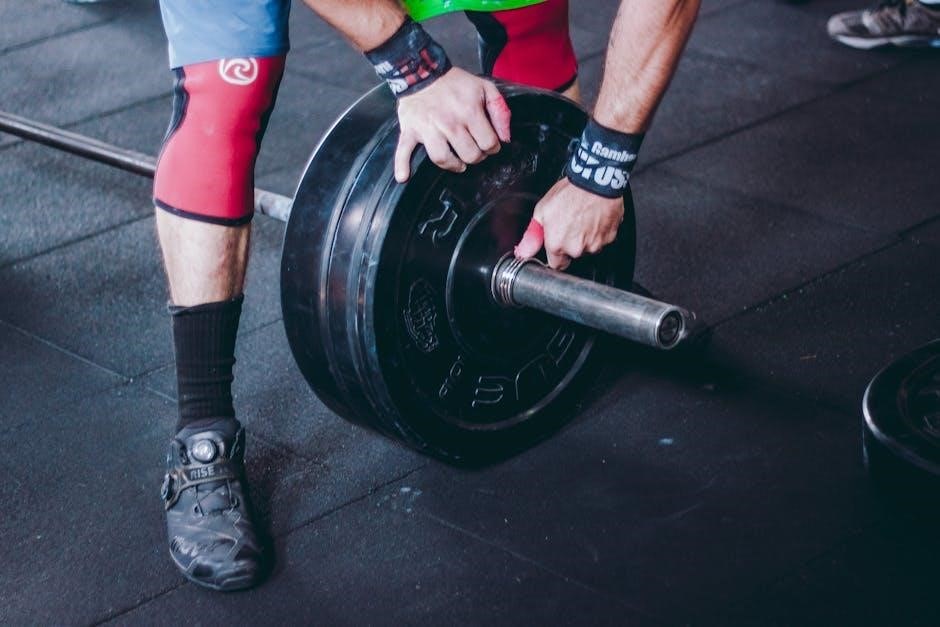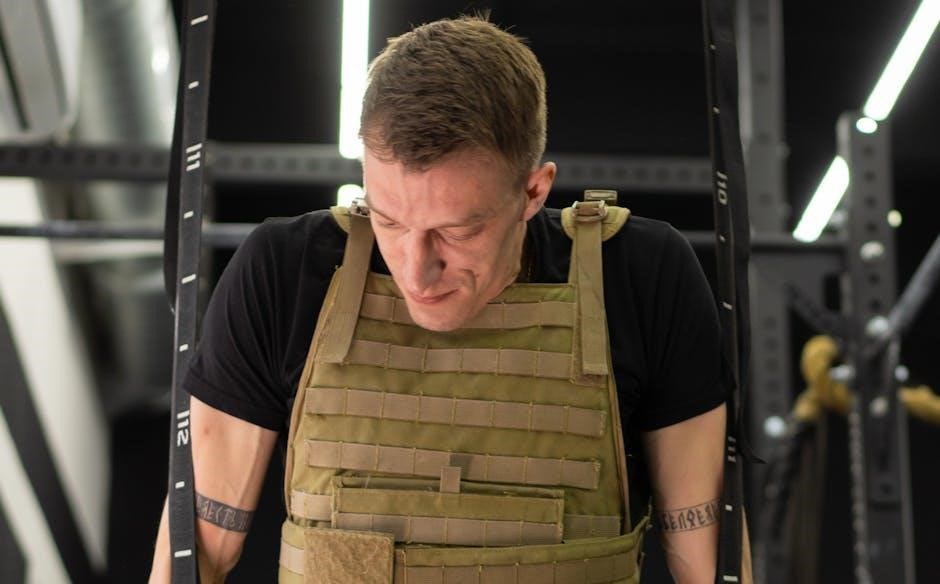Metabolic Resistance Training (MRT) combines strength training and metabolic conditioning to enhance muscle, boost metabolism, and improve cardiovascular health. It’s a powerful approach for overall fitness and weight management, suitable for all fitness levels.
1.1 What is Metabolic Resistance Training?
Metabolic Resistance Training (MRT) is a high-intensity fitness approach that combines strength training with metabolic conditioning to maximize calorie burn and improve muscular endurance. It focuses on compound movements, such as squats, deadlifts, and bench presses, performed in a way that elevates the heart rate and engages multiple muscle groups simultaneously. MRT is designed to enhance both aerobic and anaerobic capacity, making it a versatile workout for those seeking to build lean muscle, boost metabolism, and improve cardiovascular health. Unlike traditional weightlifting or cardio, MRT emphasizes intensity and efficiency, often incorporating time-under-tension and high-intensity interval training (HIIT) principles. This approach not only accelerates fat loss but also improves overall athletic performance. The science behind MRT lies in its ability to create an afterburn effect, known as excess post-exercise oxygen consumption (EPOC), where the body continues to burn calories post-workout.
1.2 Benefits of MRT for Overall Fitness
Metabolic Resistance Training (MRT) offers numerous benefits for overall fitness, including enhanced metabolic rate, improved muscular endurance, and increased cardiovascular health. It combines strength training with metabolic conditioning to create a time-efficient workout that boosts lean muscle mass and accelerates fat loss. MRT improves insulin sensitivity and promotes better glucose utilization, which is beneficial for metabolic health. Additionally, it enhances athletic performance by improving power, speed, and endurance. The high-intensity nature of MRT also stimulates the afterburn effect, known as EPOC, where the body burns calories post-workout. This approach is ideal for those seeking a balanced fitness routine, as it addresses both aerobic and anaerobic capacities. By incorporating compound movements and resistance training, MRT helps build functional strength while improving overall physical resilience. It’s a comprehensive fitness solution that supports long-term health and wellness goals, making it suitable for individuals of all fitness levels.

Components of an MRT Workout
Metabolic Resistance Training combines compound movements, resistance exercises, and metabolic conditioning to enhance strength, endurance, and cardiovascular health, supported by the science of EPOC for maximum calorie burn.
2.1 Importance of Compound Movements
Compound movements are essential in MRT as they engage multiple muscle groups simultaneously, enhancing strength, muscle mass, and metabolic efficiency. Exercises like squats, deadlifts, and bench presses target several muscles at once, improving functional strength and boosting metabolism. By recruiting more muscle fibers, compound lifts increase calorie burn and promote lean muscle growth. They also enhance joint stability and overall athleticism. Incorporating these movements ensures a time-efficient workout, making them a cornerstone of effective MRT programs. Regular practice improves muscle endurance and accelerates progress toward fitness goals, making compound movements indispensable for a well-rounded training approach.
2.2 Role of Resistance Training in MRT
Resistance training is a foundational element of MRT, designed to build muscle, increase strength, and elevate metabolism. It involves using weights, resistance bands, or body weight to challenge muscles, promoting hypertrophy and endurance. By targeting specific muscle groups, resistance training enhances overall muscle mass, which contributes to a higher resting metabolic rate. This not only aids in weight management but also improves long-term metabolic health. Resistance training in MRT is structured to maximize efficiency, combining compound and isolation exercises to ensure comprehensive muscle development. Regular resistance workouts adapt muscles to handle increasing loads, fostering progressive overload and continuous improvement. This approach ensures sustained muscle growth and metabolic benefits, making resistance training indispensable in MRT programs for achieving optimal fitness and health.
2.3 Incorporating Metabolic Conditioning
Metabolic conditioning is a critical component of MRT, focusing on exercises that enhance the body’s ability to efficiently use energy and recover. It involves high-intensity, dynamic movements designed to push both aerobic and anaerobic systems. Unlike traditional cardio, metabolic conditioning incorporates strength-based exercises, such as kettlebell swings, burpees, and jump squats, to simultaneously build muscle and improve endurance. This approach not only boosts cardiovascular health but also increases excess post-exercise oxygen consumption (EPOC), leading to prolonged calorie burn after the workout. Metabolic conditioning workouts are typically short but intense, making them time-efficient for individuals seeking to maximize results. By integrating these exercises into an MRT program, individuals can improve muscular endurance, accelerate fat loss, and enhance overall metabolic function. This combination of strength and conditioning ensures a well-rounded fitness approach, making metabolic conditioning essential for achieving the full benefits of MRT.
2.4 The Science Behind MRT and EPOC
Metabolic Resistance Training (MRT) leverages the concept of Excess Post-Exercise Oxygen Consumption (EPOC), a physiological response where the body consumes additional oxygen after intense exercise to restore energy balance. EPOC is triggered by high-intensity workouts that deplete ATP stores and disrupt metabolic homeostasis. MRT, combining strength training and metabolic conditioning, is particularly effective at inducing EPOC due to its focus on compound movements and high-energy expenditure. During MRT, the body relies on anaerobic and aerobic systems, creating a significant oxygen deficit. Post-workout, the body works to replenish energy stores, repair tissues, and stabilize metabolic processes, leading to prolonged calorie burn. This enhanced metabolic rate can last for hours, making MRT highly efficient for fat loss and improved metabolic health. The science behind EPOC underscores MRT’s effectiveness in achieving both strength and cardiovascular benefits, ensuring a comprehensive fitness approach.

Benefits of Metabolic Resistance Training
Metabolic Resistance Training enhances metabolic rate, improves muscular endurance, boosts cardiovascular health, and aids in effective weight management, making it a comprehensive approach for overall fitness and well-being.
3.1 Enhanced Metabolic Rate
Metabolic Resistance Training significantly boosts your resting metabolic rate (RMR), helping your body burn more calories at rest. This is achieved through increased lean muscle mass, which requires more energy to maintain. By incorporating compound movements and high-intensity intervals, MRT stimulates excess post-exercise oxygen consumption (EPOC), keeping your metabolism elevated long after the workout ends. This enhanced metabolic rate not only aids in weight loss but also improves insulin sensitivity and overall energy levels. Over time, consistent MRT sessions can lead to sustained metabolic improvements, making it easier to maintain weight loss and enhance long-term health outcomes. The combination of strength and metabolic conditioning ensures that your body remains in a fat-burning state, even during periods of rest, making MRT a highly effective strategy for metabolic enhancement.
3.2 Improved Muscular Endurance
Metabolic Resistance Training (MRT) significantly enhances muscular endurance by challenging muscles to work under sustained effort. Through the use of compound movements and high-intensity intervals, MRT pushes muscles to adapt, increasing their ability to perform repetitive tasks over time. This improvement in endurance is particularly noticeable during prolonged physical activity, as muscles become more efficient at utilizing energy sources. The combination of resistance and metabolic conditioning in MRT strengthens muscle fibers, delaying the onset of fatigue and improving overall stamina. Over time, this leads to better performance in both daily activities and athletic endeavors; MRT’s focus on functional movements also enhances neuromuscular coordination, further boosting endurance. By optimizing both strength and endurance, MRT creates a balanced approach to fitness, ensuring muscles are resilient and capable of meeting various physical demands effectively. This makes it an excellent choice for those seeking to improve overall muscular performance and longevity.
3.3 Increased Cardiovascular Health
Metabolic Resistance Training (MRT) significantly improves cardiovascular health by combining strength and metabolic conditioning. This approach elevates heart rate and sustains it, enhancing cardiac output and vascular function. Over time, MRT strengthens the heart, improving its ability to pump blood efficiently. Additionally, it boosts blood flow and enhances the delivery of oxygen and nutrients to tissues, which is critical for overall health. Regular MRT workouts also contribute to improved circulation, reducing blood pressure and enhancing the body’s ability to manage physical demands. Furthermore, the increased energy expenditure during MRT sessions promotes a healthier cardiovascular system, reducing the risk of heart-related diseases. By integrating both resistance and metabolic conditioning, MRT provides a comprehensive approach to improving cardiac fitness and overall well-being, making it an excellent choice for enhancing cardiovascular health.

3.4 Effective Weight Management
Metabolic Resistance Training (MRT) is highly effective for weight management due to its ability to enhance metabolism and build lean muscle. By incorporating both strength and metabolic conditioning, MRT increases the body’s resting metabolic rate, allowing it to burn more calories even at rest. This dual approach not only strengthens muscles but also boosts fat oxidation, making it easier to maintain a healthy weight. The combination of compound movements and high-intensity intervals in MRT workouts ensures sustained calorie burn long after the session ends. Additionally, MRT helps preserve muscle mass while shedding fat, which is crucial for maintaining a balanced and toned physique. Regular engagement in MRT workouts supports long-term weight management by promoting a stronger, leaner body composition and improving overall metabolic health.

Designing an Effective MRT Workout Plan
Designing an effective MRT plan involves compound movements, resistance training, and metabolic conditioning. Set clear goals, structure workouts with HIIT, and ensure progressive overload for sustained results. Balanced nutrition supports overall success.

4.1 Setting Goals and Objectives
Setting clear and achievable goals is essential for a successful MRT program. Start by defining specific, measurable, and time-bound objectives, such as improving strength, increasing endurance, or losing weight. Assess your current fitness level to create a realistic baseline. Break down larger goals into smaller, manageable milestones, ensuring progression and motivation. For instance, if aiming to enhance metabolic rate, focus on incremental increases in exercise intensity or duration. Additionally, consider personal preferences and lifestyle to maintain consistency. Tracking progress through workouts, measurements, or performance metrics helps stay on course. A well-defined plan not only guides your training but also keeps you motivated and accountable, leading to better overall results. This structured approach ensures that every session contributes meaningfully to your long-term objectives.
4.2 Structuring a Sample MRT Workout

A sample MRT workout typically combines compound movements, resistance training, and metabolic conditioning. Begin with a dynamic warm-up to prepare muscles and joints. Follow with compound exercises like squats, deadlifts, or bench presses to build strength and engage multiple muscle groups. Incorporate metabolic conditioning using high-intensity intervals, such as kettlebell swings or burpees, to elevate heart rate and burn fat. Finish with a cool-down to promote recovery. This structure enhances metabolism, improves endurance, and maximizes fat burning; The workout can be adjusted based on fitness levels, making it versatile for beginners and advanced trainees alike. By combining strength and cardio, MRT optimizes time and delivers comprehensive fitness benefits.
4.3 Incorporating High-Intensity Interval Training (HIIT)
High-Intensity Interval Training (HIIT) is a cornerstone of MRT, delivering rapid fitness improvements. It involves short bursts of maximum effort followed by brief rest periods. HIIT enhances cardiovascular health, accelerates fat loss, and boosts metabolic rate. For example, sprint intervals or burpees can be integrated into an MRT workout to maximize calorie burn during and after exercise. HIIT’s time-efficient nature makes it ideal for busy individuals seeking impactful results. When combined with resistance training, HIIT amplifies muscle engagement and endurance. Proper timing and rest periods are crucial to avoid overtraining. Incorporating HIIT into MRT creates a balanced and challenging routine that promotes long-term fitness gains. This approach ensures a dynamic and effective workout experience tailored to various fitness levels.
4.4 The Importance of Progressive Overload

Progressive overload is a critical component of MRT, ensuring continuous improvement in strength and fitness; It involves gradually increasing the intensity of workouts by adding weight, reps, or reducing rest periods. This principle prevents plateaus and challenges muscles to adapt, promoting muscle growth and enhanced metabolic function. Over time, progressive overload improves overall muscular endurance and cardiovascular health. For instance, increasing the weight used in compound movements or adding more rounds to metabolic conditioning exercises can effectively apply progressive overload. Consistency and patience are key, as gradual increases yield sustainable results. By incorporating progressive overload into MRT, individuals can achieve long-term fitness goals and maintain a high level of physical performance. This approach ensures workouts remain challenging and effective, driving continuous progress in strength and metabolic capacity.
Nutrition and Recovery for MRT

Nutrition and recovery are vital for MRT success. Proper fueling enhances performance, aids muscle repair, and supports metabolic health. Balanced meals, hydration, and sufficient sleep ensure optimal recovery and results.
5.1 The Role of Nutrition in MRT
Nutrition plays a critical role in Metabolic Resistance Training, fueling workouts and aiding recovery. A balanced diet rich in protein supports muscle repair and growth, while carbohydrates provide energy. Healthy fats are essential for hormone production and overall health. Proper hydration is also crucial to maintain performance and prevent fatigue. Additionally, timing meals around workouts can optimize results, with pre-workout meals providing energy and post-workout nutrition aiding recovery. Adequate electrolyte intake ensures proper muscle function and recovery. A well-planned diet not only enhances physical performance but also supports the body’s metabolic processes, making it a cornerstone of a successful MRT program. By prioritizing nutrition, individuals can maximize their training efforts and achieve their fitness goals more effectively.
5.2 Pre- and Post-Workout Meal Strategies
Effective pre- and post-workout nutrition is essential for optimizing performance and recovery in Metabolic Resistance Training. A pre-workout meal should include complex carbohydrates and lean proteins to provide sustained energy and prevent muscle breakdown. Timing is key, with meals ideally consumed 1-2 hours before training. Post-workout, prioritize protein and carbohydrates within 30-60 minutes to replenish glycogen stores and support muscle repair. Hydration is also critical, with electrolytes helping to restore fluid balance. Avoid processed foods and focus on whole, nutrient-dense options to maximize benefits. Tailoring meals to individual needs ensures optimal results, as everyone’s metabolic and energy requirements differ. By strategically fueling before and after workouts, individuals can enhance endurance, recovery, and overall progress in their MRT program. Proper meal planning supports the body’s ability to adapt and perform at its best.
5.3 Hydration and Electrolyte Balance
Proper hydration and electrolyte balance are crucial for optimal performance and recovery in Metabolic Resistance Training. Intense workouts lead to significant sweat loss, which can deplete essential electrolytes like sodium, potassium, and magnesium. These minerals are vital for maintaining fluid balance, nerve function, and muscle contractions. Even mild dehydration can impair strength, endurance, and focus, while severe dehydration can lead to fatigue or dizziness. To combat this, it’s recommended to drink water regularly before, during, and after workouts. Sports drinks containing electrolytes can be beneficial for prolonged or high-intensity sessions. Monitoring urine color can help assess hydration levels; pale yellow indicates proper hydration. Additionally, consuming electrolyte-rich foods or supplements can help replenish lost minerals. Maintaining proper hydration and electrolyte balance ensures the body functions efficiently, supports recovery, and maximizes the effectiveness of MRT workouts. Consistency in hydration habits is key to achieving long-term fitness goals.
5.4 Sleep and Recovery for Optimal Results
Sleep and recovery are essential for maximizing the benefits of Metabolic Resistance Training. During sleep, the body repairs and rebuilds muscle tissue, consolidates memory, and regulates hormones. Aim for 7-9 hours of quality sleep nightly to support muscle recovery and overall health. Poor sleep can lead to decreased performance, increased inflammation, and slower progress. Recovery techniques like stretching, foam rolling, and massage can reduce muscle soreness and improve flexibility. Active recovery, such as light cardio or yoga, promotes blood flow without overtaxing the body. Additionally, rest days are crucial to prevent overtraining and allow the body to adapt. Consistent sleep and recovery practices enhance endurance, strength, and metabolic function, ensuring optimal results from MRT workouts. Prioritizing these elements supports long-term fitness goals and maintains overall well-being. A balanced approach to training and recovery is key to achieving success in any fitness program.

Safety and Precautions in MRT
Proper warm-ups, form, and cool-downs are essential to prevent injuries. Listen to your body to avoid overtraining. Modify exercises to suit fitness levels and ensure safety.
6.1 Warming Up and Cooling Down
A proper warm-up and cool-down are crucial for safety and effectiveness in MRT. Start with dynamic stretches like arm circles and leg swings to boost blood flow and flexibility. Incorporate light cardio, such as jumping jacks or jogging, to prepare the heart and muscles. Mobility drills, like hip opens and torso twists, enhance range of motion and reduce injury risk. After training, cool down with static stretches for major muscle groups to improve recovery and reduce soreness. Foam rolling or self-myofascial release can also aid in muscle relaxation. Proper hydration and nutrition post-workout support recovery. Neglecting these steps can lead to injuries and suboptimal results. Consistency in warming up and cooling down ensures long-term safety and performance in MRT.
6.2 Avoiding Overtraining and Injury
Avoiding overtraining and injury is essential for sustained progress in MRT. Signs of overtraining include persistent fatigue, decreased performance, and increased soreness. To prevent this, balance intense workouts with adequate rest days. Ensure proper form during exercises to minimize injury risk. Incorporate modifications for exercises based on fitness levels. Hydration and electrolyte balance are critical to prevent muscle cramps and dizziness. Recovery strategies, such as foam rolling and stretching, can reduce muscle tension. Prioritize quality sleep to aid muscle repair and mental recovery. Overtraining can lead to burnout and long-term injuries, halting progress. Listen to your body and adjust workout intensity and volume as needed. A well-structured program with progressive overload ensures safety and continuous improvement. Consistency and patience are key to avoiding setbacks and achieving long-term success in MRT.
6.3 Modifying Exercises for Different Fitness Levels
Modifying exercises in MRT is crucial to accommodate varying fitness levels. Beginners can start with lighter weights or bodyweight exercises, while advanced individuals can use heavier loads or complex movements. For example, squats can be modified to bodyweight or assisted versions for those with mobility issues. Progressions, such as increasing reps or intensity, ensure continuous challenge. Proper form must be maintained to prevent injuries, even as exercises are scaled. Trainers can substitute movements to suit individual capabilities, ensuring everyone benefits. A well-structured MRT program allows for customization, fostering inclusivity and safety. This approach ensures that all participants, regardless of fitness level, can achieve their goals effectively. Regular reassessment of fitness levels helps tailor workouts for optimal progress and injury prevention. By adjusting exercises appropriately, MRT remains accessible and beneficial for everyone.

